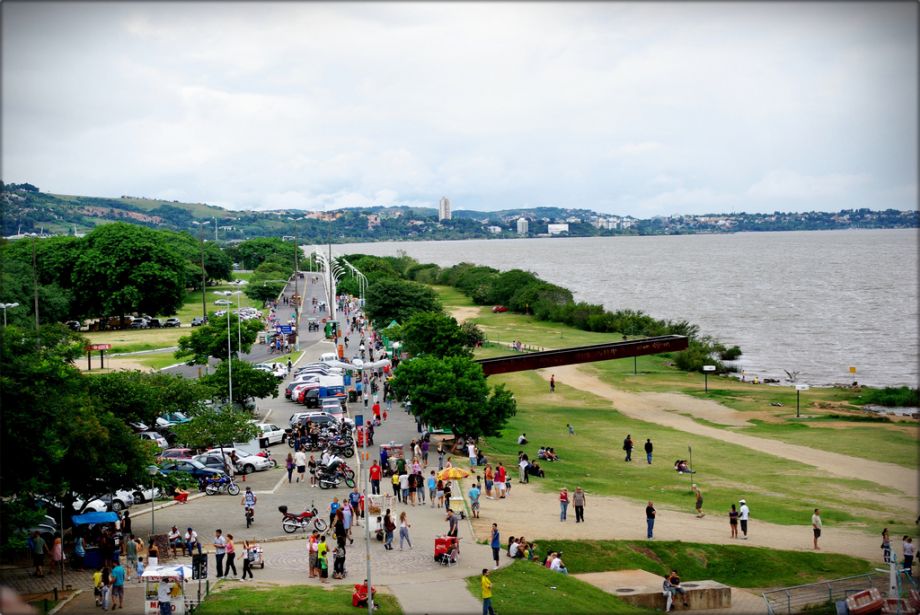On an unseasonably warm Friday afternoon in Brazil’s wintry July, the sun hung low in the sky on its way to the horizon. Couples strolled casually soaking up the rays, a young guy strummed a guitar while sitting in the grass and several dozen people ready to greet the weekend sat to watch, sipping chimarrão, the ubiquitous local tea known elsewhere as yerba mate. The scene was downtown Porto Alegre on the shores of the Guaíba Lake, the vast body of water that abuts the city to the west.
The most popular spot from which to watch the sinking sun is in the shadow of the Usina do Gasômetro, a 1920s gem of industrial architecture whose coal-fired power plant was decommissioned in 1970, saved from demolition in the 1980s, and ultimately preserved as a cultural center that has become a civic icon with its towering brick chimney. In 1988, four activists from APAGAN, the state’s oldest environmental advocacy group, climbed the chimney and unfurled a banner that read “No to the Guaíba Beach Project.” Their transgressive act came in the throes of Brazil’s democratic transition and successfully kept privatization of the lakefront at bay.
A quarter-century later, Guaíba’s shores continue to be a cherished, and controversial, urban waterfront. Its 62 kilometers (38.5 miles) within the city limits are a patchwork. One-off public parks cling to the downtown end while private social clubs at the water’s edge dominate further south. Brand new bike and jogging paths run as far as the Beira-Rio (Riverfront) Stadium, which hosted five World Cup games, but are absent elsewhere. Playing fields are ragged and much of the open space lacks any landscape design.
In 2012, Jaime Lerner Arquitetos Associados (JLAA), a private firm headed by the famous former mayor of neighboring Curitiba, was hired by the city government for R$2.1 million ($900,000 USD) to develop a master plan for a 5.9-kilometer (3.7-mile) stretch of the Guaíba that fronts downtown. It rankled the local design and environmental communities alike. Architects were upset because Lerner’s firm was selected on the basis of notório saber, or recognized expertise, in lieu of a public competition. Waterfront activists were frustrated that his plans seemed to ignore 25 years of research, planning and advocacy on behalf of the troubled waterway.
Udo Mohr, both a building and landscape architect, straddles these two worlds. He is currently an advisor to AGAPAN and formerly coordinated a plan for the Jaguí Islands in Guaíba Lake, which cover some 200 square kilometers (77 square miles). Mohr grew up swimming in the Gauíba and camping on its beaches. “It was unpolluted at that time, in the 1930s, when my family moved to Porto Alege. My kids were born in the 1960s and it was still swimmable then,” he recalls.
Like many urban waterways, raw sewage and trash have taken their toll, rendering the once pristine lake less than healthy. To Mohr’s mind, any master plan for the Guaíba has to focus on environmental sustainability and resiliency. Instead, he says, JLAA’s plan keeps conjuring up two words for him: “insane” and “absurd.” Whether ideas for a shopping mall and parking lot adjacent to the Gasômetro, the use of non-native palm species in the renderings, or plans for public lighting that biologists fear will affect birds and insects, Mohr echoes famed landscape architect Ian McHarg: “The waterfront should be integrated with nature.” He continues: “It’s too urban, Copacabana style. Whoever designed this has no idea about Porto Alegre.”
There may be an element of nativism in this critique, as Taco Roorda, an architect at JLAA, affirms that the design team prepared everything in accordance with the city’s master plan, which has a specific article on the waterfront, as well as two studies prepared by city hall in the 2000s on the Guaíba’s urban planning and design potential. He refutes some of Mohr’s assertions, claiming that there is already a parking lot near the Gasômetro and that the trees shown in a rendering are not what will be planted in the final product. Moreover, he points to a riparian barrier of vegetation from the shoreline to two meters (6.5 feet) inland as a buffer against flooding, to which the Guaíba is prone. Citing the public parks that have already resulted from piecemeal waterfront planning, Roorda argues, “Our plan will reinforce ties between the various projects and, fundamentally, with the city itself.”
Whatever the merits of JLAA’s plan, Mayor José Fortunati has moved it forward. On September 4, in a ceremony that featured Lerner, he announced a R$57 ($25 USD) million bid to implement the design scheme, a project scheduled to break ground in the first trimester of 2015. For participation-minded Porto Alegre, however, the selection without a public competition left a bad taste in the city’s mouth, at least among its design professionals, and has contributed to these kinds of disagreements between JLAA and local architects.
Tiago Holzmann, president of the Rio Grande do Sul chapter of the Brazilian Institute of Architects (IAB-RS), was instrumental in forcing a heated city council meeting last year that opened Lerner to criticism and downright boos from the general public. The IAB-RS has presided over several design competitions in the past for major projects in the city. While there is nothing illegal about using notório saber, he calls it “a strange and obscure part of the law that allows for this retrograde possibility of handing out contracts directly to ‘notable’ friends.”
Despite the public hearing in October 2013, Holzmann insists that citizen participation was “nonexistent” and that the actual plans for the project were never made public. “Nothing more than some colorful perspective drawings,” he claims. Mohr likewise says he has yet to seen any architectural or landscape plans. With the window before groundbreaking about as low on the horizon as a Guaíba sunset, Holzmann remains firm if despondent. “We’re going to try and improve the project as soon as we have actual access to it. This was formally requested but never appeared,” he laments. The motivation for this stonewalling could not be ascertained as both the city’s secretary of special projects and secretary of urbanism did not return calls for comment. By next year, it seems likely that Porto Alegre will experience some version of Lerner’s poetic, if idealized, vision: “Where the sunset ends, the chão de estrelas [“field of stars,” a 1960s singer-songwriter classic] begins.”

Gregory Scruggs is a Seattle-based independent journalist who writes about solutions for cities. He has covered major international forums on urbanization, climate change, and sustainable development where he has interviewed dozens of mayors and high-ranking officials in order to tell powerful stories about humanity’s urban future. He has reported at street level from more than two dozen countries on solutions to hot-button issues facing cities, from housing to transportation to civic engagement to social equity. In 2017, he won a United Nations Correspondents Association award for his coverage of global urbanization and the UN’s Habitat III summit on the future of cities. He is a member of the American Institute of Certified Planners.





_on_a_Sunday_600_350_80_s_c1.jpeg)

_1200_700_s_c1_600_350_80_s_c1.jpg)









